Pistachio-Herb Crusted Pork Rib Roast: An Elegant Oven-Roasted Masterpiece
Are you searching for a show-stopping main course that’s surprisingly simple to prepare yet guaranteed to impress your guests? Look no further than this magnificent oven-roasted pork rib roast. This recipe delivers a perfectly juicy and exceptionally flavorful bone-in cut of pork, adorned with a golden, aromatic crust made from pistachios, garlic, and fresh herbs. It’s an ideal choice for a festive holiday meal, a special Sunday dinner, or any occasion where you want to serve something truly extraordinary. Despite its impressive appearance, this dish is straightforward to execute, making it accessible for home cooks of all skill levels. Allow us to guide you through the process of creating this unforgettable centerpiece, ensuring a tender, flavorful, and beautifully presented roast every time.
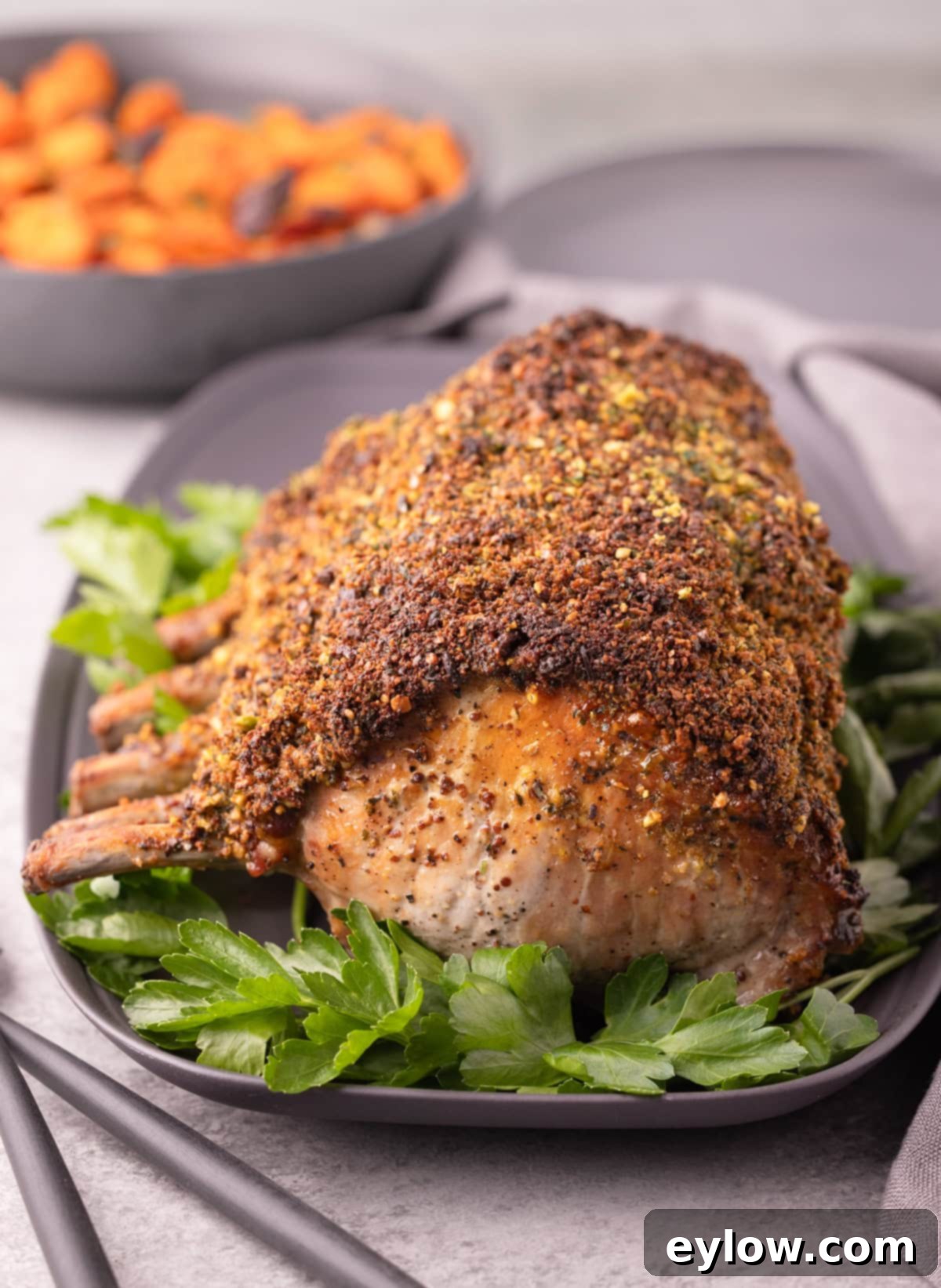
Transform your next gathering into a culinary event with this stunning roasted rack of pork. Many believe such an elegant dish requires advanced skills, but you’ll discover it’s far easier than it appears. The secret lies in the tender, succulent meat coupled with a vibrant pistachio-herb crust that comes together quickly in a food processor. Once this flavorful roast enters the oven, it demands minimal attention, freeing you to focus on other aspects of your meal or simply enjoy time with your loved ones. Whether it’s a grand holiday feast or a cozy family Sunday dinner, this pistachio-crusted pork rib roast is sure to earn you enthusiastic compliments and requests for the recipe. Its golden exterior and moist interior make it a memorable dish for any discerning palate.
Achieving a succulent pork roast is all about a few key techniques: selecting the right cut, preparing a flavorful crust, and monitoring the internal temperature diligently. This recipe masterfully combines these elements to create a dish that is both approachable and gourmet. The bone-in nature of the roast contributes significantly to its tenderness and deep flavor, as the bones help distribute heat evenly and prevent the meat from drying out. The unique pistachio-garlic-herb crust not only adds a beautiful golden finish and incredible texture but also infuses every bite with a complex, savory aroma. We’ll walk you through each step, from selecting the perfect rack of pork to carving it into impressive chops, ensuring you confidently create a dish that’s both delicious and picture-perfect. Get ready to elevate your roasting game with this exceptional recipe.
[feast_advanced_jump_to]
Why You’ll Love This Elegant Pork Rib Roast Recipe
This Pistachio-Herb Crusted Pork Rib Roast isn’t just a meal; it’s an experience. Here’s why this recipe will quickly become a favorite in your culinary repertoire, delivering both impressive results and cooking enjoyment:
- Effortlessly Elegant: Despite its gourmet appearance and rich flavor profile, this pork rib roast is surprisingly simple to prepare. It’s truly a holiday-worthy and special occasion dish that doesn’t require hours of intricate work in the kitchen. Impress your guests, family, and friends with a magnificent centerpiece without the usual stress associated with elaborate meals. Its presentation alone will garner attention!
- Unforgettable Flavor-Packed Crust: The star of this dish, beyond the succulent pork itself, is the vibrant, aromatic crust. A harmonious blend of crunchy, nutty pistachios, pungent fresh garlic, fragrant fresh flat-leaf parsley, and earthy thyme creates a golden, irresistible coating. This crust not only adds incredible textural contrast to the tender meat but also infuses the entire roast with layers of savory, herbaceous goodness that will have everyone asking for your secret.
- Incredibly Juicy, Bone-In Pork: Roasting pork on the bone is a time-honored technique that dramatically enhances both moisture and flavor. The bones conduct heat more slowly and evenly than boneless cuts, effectively protecting the surrounding meat and preventing it from drying out during the roasting process. This method ensures every single slice of your pork rib roast is exceptionally tender, incredibly juicy, and packed with that rich, inherent pork flavor. It’s a cut above boneless options, delivering a superior, more satisfying dining experience that celebrates the natural qualities of the meat.
- Perfect for Any Occasion: While this roast shines brightly as the magnificent centerpiece of a holiday feast, such as Thanksgiving, Christmas, or Easter, its relative ease of preparation also makes it wonderfully suitable for a lavish Sunday dinner with family or even a sophisticated weeknight meal when you want something a bit special. It strikes the perfect balance between being an impressive main dish and one that’s genuinely approachable for home cooks.
If you appreciate the rich flavor and culinary versatility of pork, and are looking for other impressive but manageable dishes, you might also enjoy exploring this roast pork tenderloin with Dijon mustard sauce for another delightful culinary adventure that showcases pork’s delicious qualities.
Essential Ingredients for Your Pistachio-Crusted Pork Rib Roast
Crafting this exceptional pistachio-crusted pork rib roast requires a careful selection of fresh, high-quality ingredients. Each component plays a crucial role in building the dish’s incredible flavor, texture, and overall appeal. Here’s a closer look at what you’ll need to create this culinary masterpiece:

- Pork: The undeniable star of the show is a bone-in pork rib roast. This premium cut is often referred to as a “rack of pork” or a “pork loin rib roast.” For the best cooking and carving experience, we highly recommend asking your butcher for one with the chine bone already removed; this makes separating the individual chops after roasting significantly easier. The presence of the bone not only adds a beautiful, rustic presentation but also significantly enhances the meat’s flavor and helps to keep it wonderfully moist and tender throughout the entire roasting process.
- Pistachios: For the crunchy, aromatic crust, you’ll need raw, shelled, and unsalted pistachios. Using unsalted nuts is critical as it allows you to precisely control the overall seasoning of your dish, preventing it from becoming too salty. Raw pistachios are preferred because they toast beautifully in the oven alongside the pork, releasing their full nutty aroma and developing a rich, golden hue. Avoid pre-roasted or salted varieties for this recipe.
- Breadcrumbs: These ingredients play a vital role in the crust, acting as a binder that helps the nut-and-herb mixture adhere to the pork, while also contributing to its golden-brown, crispy texture. You have the flexibility to use either seasoned gluten-free breadcrumbs if you have dietary restrictions or regular seasoned breadcrumbs. The seasoned variety adds an extra layer of savory, herbaceous flavor to the crust, enhancing its complexity.
- Herbs: Fresh herbs are absolutely non-negotiable for the crust’s vibrant taste and enticing aroma. You’ll need fresh flat-leaf parsley, often known as Italian parsley, for its bright, clean, slightly peppery flavor. Additionally, fresh chopped thyme is essential, offering an earthy, subtly peppery note that classically complements and deepens the inherent flavor of pork. The freshness of these herbs makes a significant difference.
- Mustard: A clever combination of two types of Dijon mustard is employed here to create the perfect adhesive layer for the crust and to introduce a subtle, piquant tang that beautifully cuts through the richness of the pork. Both whole grain Dijon mustard, with its distinct grainy texture and mild spice, and creamy Dijon mustard contribute effectively to the overall flavor profile and ensure the crust ingredients bind securely to the roast.
- Garlic: Fresh garlic cloves are indispensable for the aromatic pistachio-herb crust, providing a sharp, pungent, and savory kick that elevates the entire dish. In addition to the fresh garlic in the crust, granulated garlic is recommended for seasoning the pork directly before the crust is applied. This technique offers a more mellow, pervasive garlic flavor that permeates the meat, adding depth without overpowering.
For precise measurements of each of these essential ingredients, along with recommendations for kosher salt and freshly ground black pepper, please refer to the comprehensive recipe card located further down the page. Remember, starting with high-quality ingredients is the foundation for a truly delicious and memorable meal.
To further complement this exquisite pork rib roast and create a well-rounded meal, consider serving these buttery baby Dutch yellow potatoes – their creamy texture, subtle sweetness, and delicate herb seasoning make them an absolutely perfect pairing. The combination of succulent pork, a crunchy, aromatic crust, and tender, flavorful potatoes creates a truly balanced and satisfying dining experience for any special occasion.
Customizing Your Pork Rib Roast: Delicious Substitutions and Variations
One of the most rewarding aspects of cooking is the freedom to adapt recipes to your personal taste preferences, what you conveniently have on hand in your pantry, or to accommodate specific dietary requirements. This pistachio-crusted pork rib roast recipe is wonderfully versatile, offering several delicious and easy substitutions and variations without compromising its elegant appeal or core deliciousness. Feel empowered to experiment with these ideas to truly make this recipe your own signature dish:
- Alternate Nuts: While pistachios provide a unique flavor and a beautiful green hue to the crust, you can certainly substitute them with other nuts to create a different yet equally delicious flavor profile. Consider using finely chopped walnuts or pecans; these nuts toast exceptionally well and add a distinct earthy richness that complements pork beautifully. For a milder, more buttery note, blanched and chopped almonds would also work wonderfully. Ensure any nuts you choose are raw and unsalted, allowing you to control the seasoning.
- Herb Alternatives: The fresh herb combination in this recipe is quite flexible. Beyond the classic parsley and thyme, several other aromatic herbs pair wonderfully with pork, allowing you to explore different flavor dimensions. Try incorporating some fresh rosemary for its distinct piney, highly fragrant aroma, or if fresh is unavailable, about half the amount of dried rosemary will suffice. Fresh or dried sage also makes an excellent, traditional addition, lending a warm, slightly peppery, and intensely aromatic flavor that is a classic pairing with pork dishes. Feel free to mix and match your favorite herbs to find a blend that perfectly suits your palate.
- Garlic Options: If you find yourself without fresh garlic cloves, or simply prefer a more convenient option, there’s no need to fret. You can easily substitute the fresh garlic in the crust with ½ teaspoon of garlic powder. While fresh garlic typically offers a more pungent and vibrant flavor, garlic powder provides a readily available alternative that still delivers a savory garlic essence to the crust. Just be sure to use garlic powder, not garlic salt, to maintain precise control over the overall sodium content of your dish.
- Crust-Free Simplification: For a more minimalist approach, or when you’re short on time, you can choose to skip the pistachio crust entirely. This option, while simpler, still yields an incredibly flavorful and tender roast, allowing the natural, rich taste of the pork to truly shine. To prepare it crust-free, simply brush the entire roast generously with a good quality olive oil, then season it thoroughly and evenly with kosher salt, freshly ground black pepper, a touch of granulated garlic, and a selection of your favorite dried herbs (such as rosemary, thyme, or sage). Roast as directed, vigilantly monitoring the internal temperature for doneness. This minimalist approach still results in a deeply satisfying and aromatic roast.
Beyond the main roast, don’t overlook the importance of your side dishes, which can significantly enhance the overall meal experience! These simple yet incredibly delicious whipped sweet potatoes with rosemary offer a wonderful contrasting sweetness and a velvety, creamy texture that beautifully complements the savory and crisp pork. Their herbaceous notes from the rosemary would also tie in wonderfully with the roast’s flavor profile, creating a cohesive and delightful meal.
Chef’s Tip for Buying a Rack of Pork: When selecting your pork rib roast, also known as a rack of pork, pay close attention to the fat cap. Look for a roast with a smooth, even, and relatively thin but solid layer of fat on top. This fat cap is crucial: it helps the herb-pistachio crust adhere beautifully, renders down during roasting to naturally baste the meat, and protects the underlying pork from drying out, ultimately ensuring a tender, incredibly juicy, and succulent result. A full, bone-in pork rib roast can have as many as 10 ribs, weighing approximately 9 pounds – this impressive size is perfect for a large holiday gathering or feeding a substantial crowd. However, if you’re cooking for a smaller family or fewer guests, simply ask your butcher to cut a 5-rib roast, which typically weighs around 4 pounds. This provides a more manageable portion without sacrificing any of the grandeur or flavor. For an truly elevated flavor experience, it’s highly recommended to seek out pasture-raised or heritage pork rather than conventional commodity pork. These varieties often boast superior marbling and a richer, more nuanced flavor that truly shines in a special, celebratory dish like this.
Mastering the Art of Oven-Roasted Pork Rib Roast
Roasting a pork rib roast to perfection involves a few straightforward yet critical steps that collectively ensure a moist, tender interior and a beautifully golden, flavorful, and crispy crust. Follow these detailed instructions carefully for an unforgettable meal that will impress everyone at your table:
Begin by pre-heating your oven to a precise 325°F (160°C). You might find yourself wondering why such a seemingly low oven temperature is recommended, especially when many roasting recipes typically call for a high initial sear. The reason is simple and absolutely crucial for the success of this particular recipe: the delicate nut and herb crust. A lower, more consistent oven temperature is essential to prevent the pistachios and fresh herbs in your exquisite crust from burning or charring prematurely before the pork has had sufficient time to cook through to its desired internal temperature. This gentle, steady heat allows the crust to slowly crisp, toast, and turn a beautiful golden brown without any risk of drying out or burning, thereby ensuring a perfect texture and a rich, unblemished taste. Patience with the oven temperature is key to perfection here.
Throughout the entire roasting process, it’s imperative to continuously monitor the color of your crust. It’s well-known that ovens can vary significantly in their actual temperature and how they distribute heat, so constant vigilance is important, especially as you approach the end of the cooking time. If you observe that the top of your glorious crust is browning too quickly or appears to be getting overly dark, simply tent the roast loosely with a piece of aluminum foil. This acts as a protective shield, effectively blocking direct heat from the top and preventing any over-browning or burning of the nuts and herbs, while still allowing the underlying meat to continue cooking gently and evenly to the desired internal temperature. This small, proactive step ensures your crust remains beautifully golden and utterly delicious, never scorched or dry.
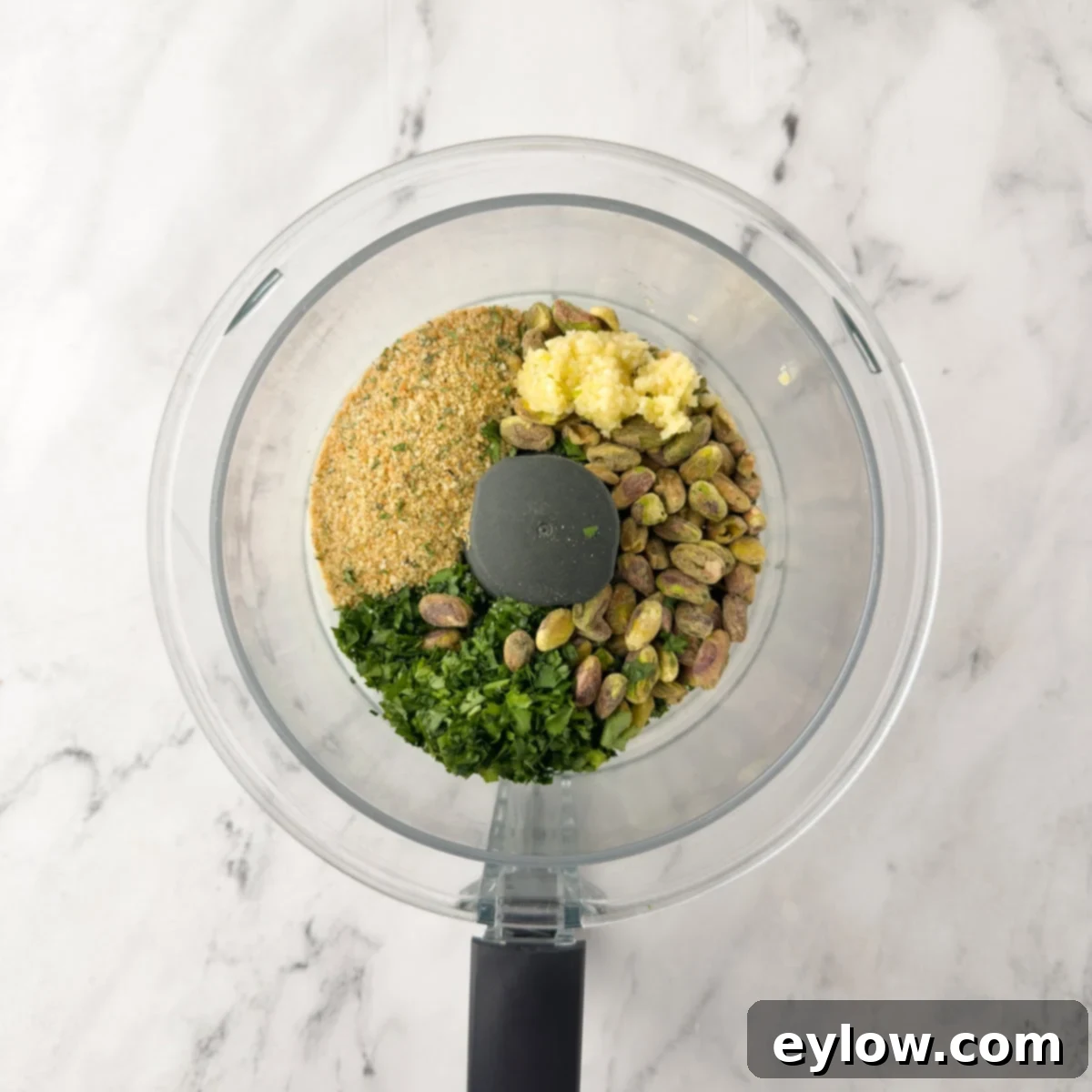
- Prepare the Pistachio-Herb Crust: Begin by gathering all the necessary ingredients for your flavorful pistachio crust. This includes raw unsalted pistachios, vibrant fresh flat-leaf parsley, seasoned breadcrumbs (either gluten-free or regular), aromatic fresh chopped thyme, and pungent fresh garlic cloves. Carefully add all these ingredients directly into the work bowl of a food processor.
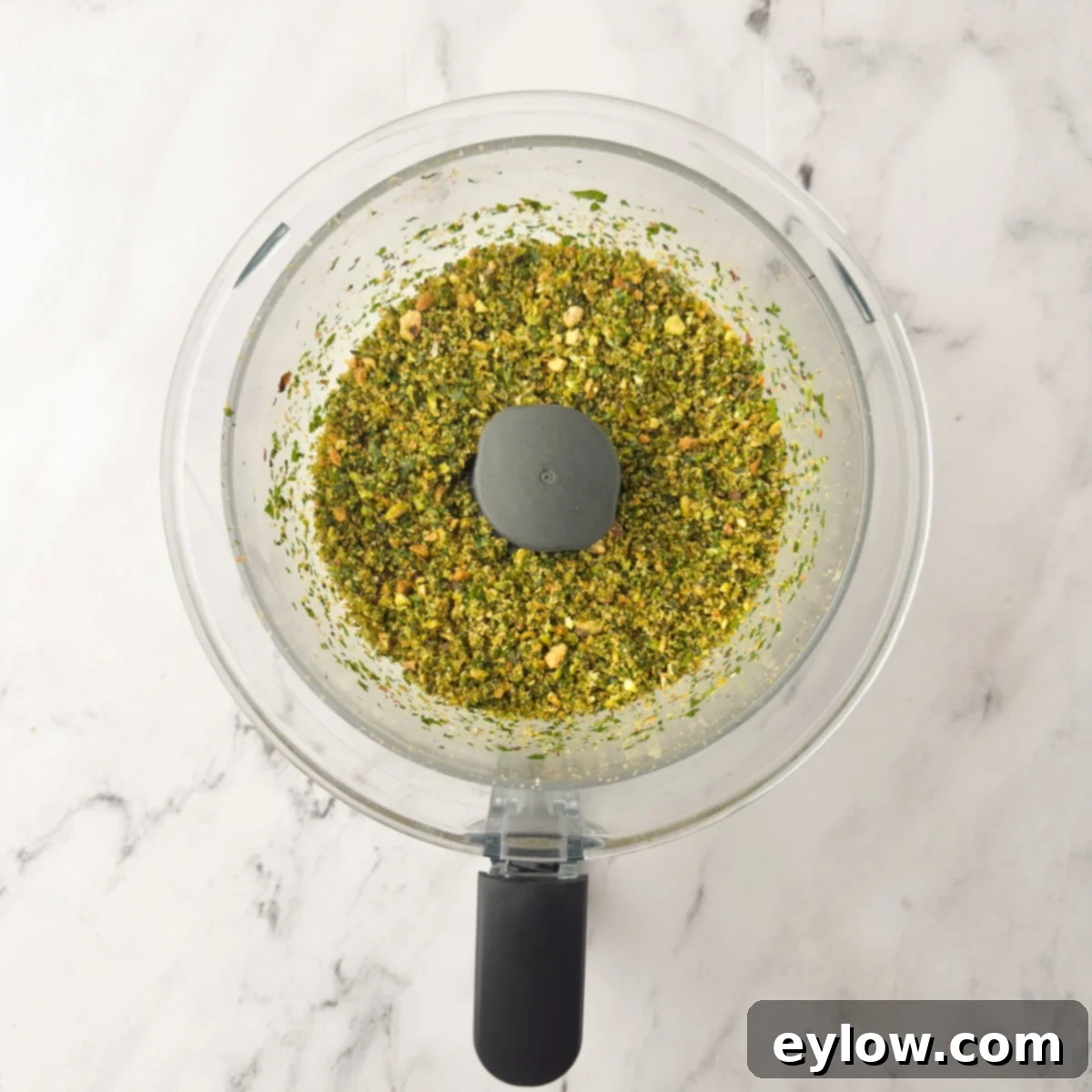
- Process the Crust Ingredients: Pulse and process the ingredients in the food processor until the mixture is finely chopped but still retains a slight texture. You are aiming for a coarse crumb-like consistency, not a smooth paste. This texture is absolutely ideal for creating a crisp, golden, and satisfyingly textured crust on your roast. If you do not have a food processor, do not fret; simply chop all the nuts, herbs, and garlic very finely by hand, then combine them thoroughly in a bowl until well mixed.

- Prepare and Season the Pork: Start by thoroughly patting the pork rib roast completely dry with paper towels. This crucial step ensures that you achieve a beautiful, even sear and that the mustard binder and crust adhere properly to the meat. If your roast came tied with butcher’s twine, you have the option to remove it if you prefer to have individual chops after cooking, or you can leave it for a more cohesive roast presentation. Season both sides and the ends of the pork rib roast generously with kosher salt, freshly ground black pepper, and optionally, a light dusting of granulated garlic for an extra layer of savory flavor directly on the meat.
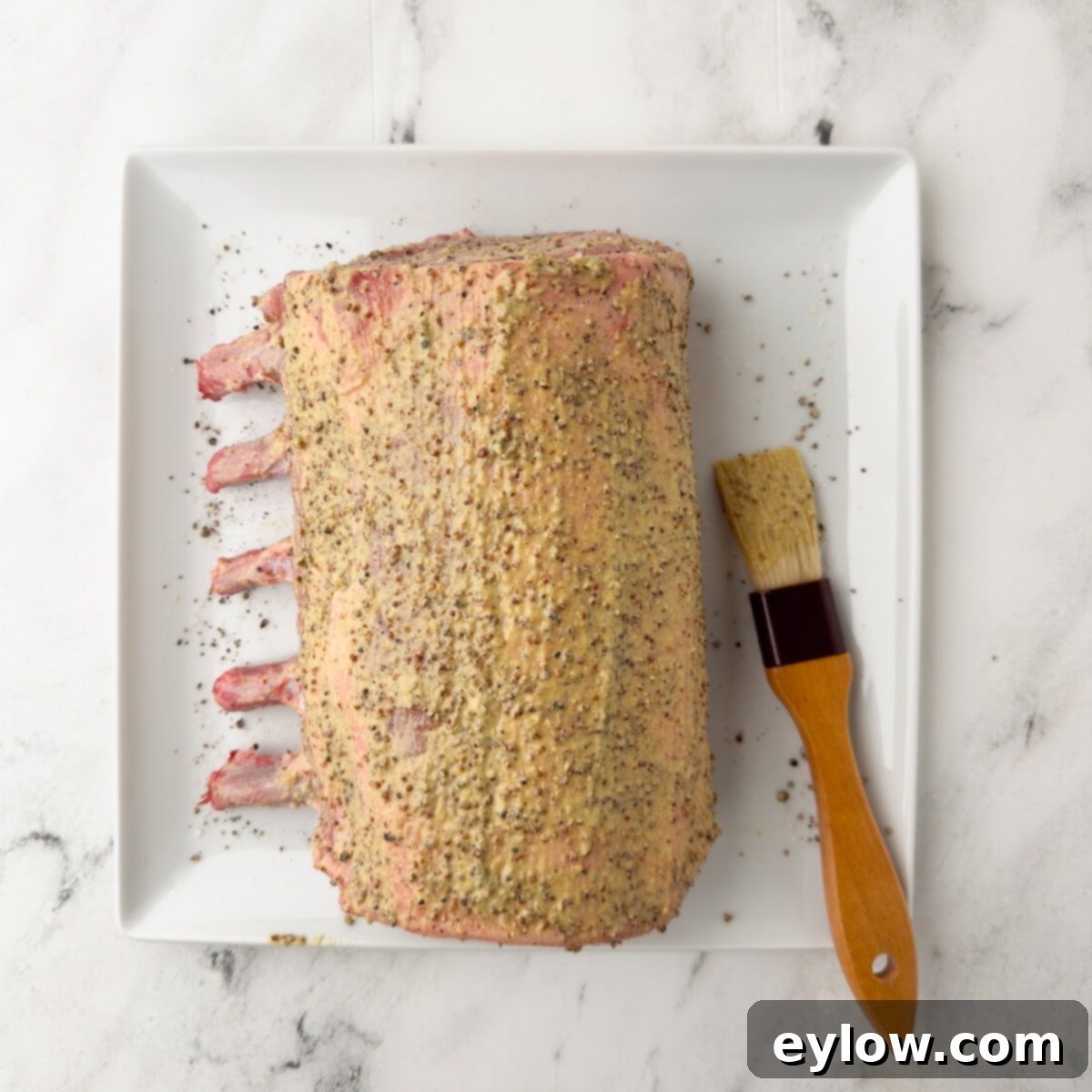
- Apply the Mustard Binder: In a small, clean bowl, thoroughly mix together the creamy Dijon mustard and the whole grain Dijon mustard until well combined. This thoughtful blend provides both smooth spreadability and a delightful hint of texture. Evenly brush this mustard mixture over the entire top side of the pork rib roast. This mustard layer serves a vital dual purpose: it acts as a flavorful and tenacious adhesive, ensuring the pistachio-herb crust sticks perfectly, and it adds a subtle yet piquant note that beautifully complements and balances the inherent richness of the pork. Finally, prepare your shallow roasting pan by placing a sturdy wire rack inside it, ready for the roast.
Chef’s Tip: Achieving an Evenly Cooked and Crispy Crust. For the absolute best results when roasting a pork rib roast, it is critically important to elevate your meat off the bottom of the pan. This simple technique allows hot air to circulate freely and uniformly around all sides of the roast, which is instrumental in promoting even cooking and, most crucially, in helping the delicious pistachio-herb crust to stay perfectly crisp and prevent it from becoming soggy. A sturdy wire rack set inside your roasting pan is the ideal tool for achieving this airflow. This is my absolute go-to method for ensuring superior texture and consistent results. If you don’t possess a dedicated wire roasting rack, a clever and effective alternative is to lay a few sturdy celery stalks or even thick slices of onion across the bottom of the roasting pan. These will elevate the roast sufficiently to allow for proper air circulation. While I’ve personally tried the celery trick in a pinch and can confirm it works well, a proper silicone roasting rack or a traditional metal wire rack remains the best long-term investment for consistently perfect roasting results.
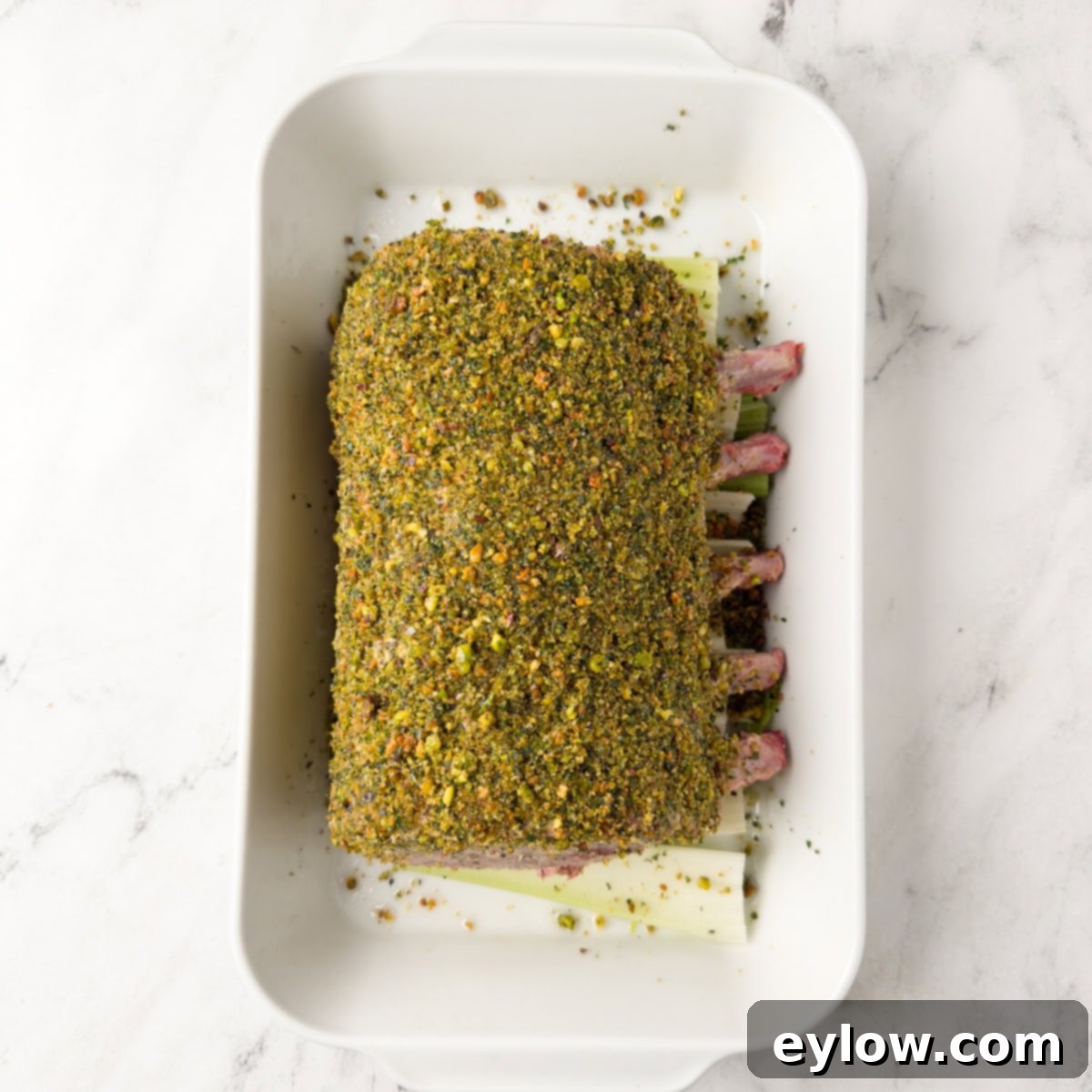
5. Apply the Crust and Roast: Generously cover the entire top side of the pork rib roast with the prepared pistachio-herb crust mixture. Gently pat the crust on firmly and evenly with your hands to ensure it adheres well and forms a cohesive layer over the mustard binder. Carefully transfer the crusted roast to your prepared roasting pan (equipped with the wire rack) and place it into the pre-heated 325°F (160°C) oven, utilizing the conventional setting. For accurate cooking, insert a reliable wireless or wired digital meat thermometer into the thickest part of the meat, being very careful to ensure the probe does not touch any bone, which could give a false reading. Roast until the internal temperature of the pork reaches 140°F (60°C). For a typical 4-pound, 5-rib roast, this process usually takes approximately 2 hours to 2 hours and 20 minutes, but it is absolutely crucial to remember that actual cooking times will vary depending on the specific calibration of your oven and the exact size and shape of your particular roast. The target internal temperature upon removal is precisely 140°F (60°C) because the roast will continue to cook as it rests outside the oven, rising naturally to the perfectly pork-safe and deliciously juicy temperature of 145°F (63°C).
Chef’s Tip – How to Know When Your Roast is Perfectly Done: The single most crucial step to achieving a perfectly cooked, incredibly juicy, and tender pork rib roast is accurately monitoring its internal temperature throughout the cooking process. Relying solely on estimated cooking times can lead to frustratingly overcooked, dry meat or, worse, dangerously undercooked pork. This is where an accurate meat thermometer becomes your absolute best friend in the kitchen. If your oven is equipped with a built-in temperature probe, take advantage of it for unparalleled convenience. Otherwise, a high-quality wireless thermometer, such as a Meater smart meat thermometer (which I personally highly recommend for its precision and ease of use, especially for both grilling and roasting), or a traditional but reliable wired meat thermometer is an invaluable tool for any serious home cook. I strongly advise against repeatedly opening the oven door to use a handheld instant-read thermometer for continuous monitoring during roasting. Each time you open the oven, you cause a significant and undesirable drop in oven temperature, which not only extends the overall cooking time but also potentially negatively affects the development and crispness of your beautiful crust. Investing in a reliable wireless or wired thermometer is a wise decision that will pay dividends in consistently perfect results for all your roasts, ensuring succulent meat every time.
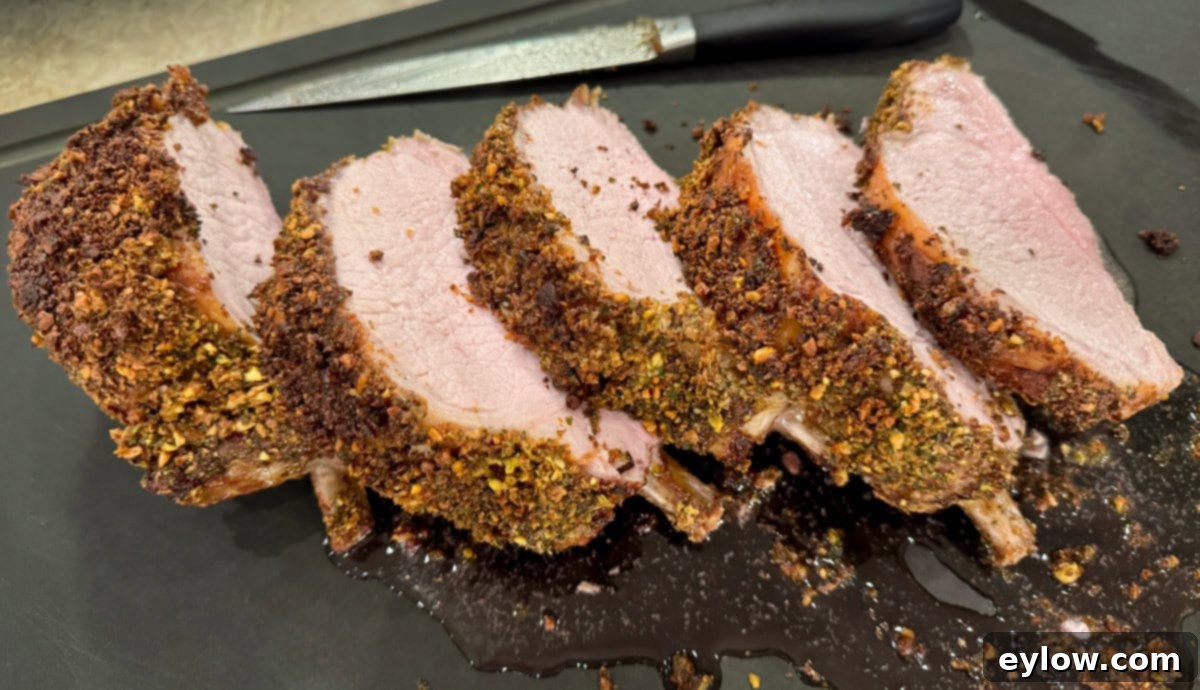
6. Rest and Slice: Once your pork rib roast reaches the critical target internal temperature of 140°F (60°C), it is imperative to remove it from the oven immediately. This next step is arguably as crucial as the roasting itself for a truly exceptional result: allow the roast to rest undisturbed for a minimum of 15 to 20 minutes. Resting is a vital process that permits the muscle fibers in the meat to relax and, more importantly, to reabsorb the flavorful juices that have been pushed towards the center during the heat of cooking. Skipping this essential resting period will inevitably result in a significant loss of these precious juices flowing out onto your cutting board, leaving you with a noticeably drier and less flavorful roast. After the resting period is complete, carefully transfer the roast to a sturdy cutting board. For both elegant presentation and ease of serving, use a sharp carving knife to slice the roast precisely between the ribs, creating beautifully thick and individual pork rib chops. A cutting board equipped with a juice groove is highly recommended, as it will neatly collect any delicious escaping juices, which can then be generously drizzled over the sliced pork for an extra burst of savory flavor and moisture.
Delectable Serving Suggestions for Your Pork Rib Roast
A magnificent and flavorful dish like this Pistachio-Herb Crusted Pork Rib Roast deserves equally impressive and well-chosen accompaniments to create a truly memorable meal. Selecting the right side dishes can significantly elevate the entire dining experience, balancing textures, complementing flavors, and adding visual appeal. Here are some of my favorite pairings that are sure to delight your palate and enhance your spectacular roast:
- Classic Creamy Riced Mashed Potatoes: The smooth, velvety texture of classic riced mashed potatoes provides a comforting and delightful contrast to the crisp, flavorful crust of the pork. Their mild, creamy flavor acts as a perfect, soothing canvas, allowing the rich, savory notes of the pork and the vibrant, aromatic crust to truly shine. A generous dollop of butter, a swirl of fresh chives, or a rich gravy (optionally made from the pan drippings for extra depth) would make this combination absolutely irresistible and satisfying.
- Roasted Brussels Sprouts with Balsamic Glaze: For a touch of vibrant freshness and a delightful tangy counterpoint, serve elegantly roasted balsamic glaze Brussels sprouts. The characteristic slight bitterness of the Brussels sprouts, which becomes beautifully mellow and caramelized from roasting, and the bright, sweet-tart reduction of balsamic glaze, expertly cuts through the richness of the pork, providing a refreshing balance. Alternatively, for a simpler yet equally effective green vegetable side, elegantly blanched green beans, lightly tossed with a knob of butter and a pinch of flaky sea salt, offer a fresh, crisp texture that works wonderfully well with the roast.
- Sweet Potato Puree or Roasted Root Vegetables: The subtle, natural sweetness of a smooth sweet potato puree or a medley of roasted root vegetables, such as tender carrots, earthy parsnips, and golden potatoes, complements pork exceptionally well. This combination offers an earthy, wholesome side that beautifully soaks up all the delicious pan juices and rich flavors of the roast. Consider infusing your sweet potato puree with a hint of cinnamon or maple syrup for added warmth.
- A Light, Fresh Salad: To elegantly lighten the meal and introduce a cleansing element, a crisp green salad tossed with a bright, zesty vinaigrette can provide a refreshing counterpoint to the rich main course. Imagine a mix of delicate greens with thinly sliced tart apples or crisp pears, a sprinkling of toasted walnuts or candied pecans for crunch, and a vibrant lemon-herb dressing. This adds a crucial element of freshness.
- Don’t Forget Dessert: To conclude your exquisite meal on a high note, prepare a delightful and often make-ahead dessert. An easy strawberry panna cotta is a fantastic choice, especially for entertaining. Its silky, creamy texture and bright, fresh fruit flavor offer a light, elegant, and perfectly sweet finish that won’t overwhelm your guests after such a satisfying and flavorful main course. It provides a palate-cleansing sweetness that perfectly caps off the experience.
These thoughtful suggestions are meticulously designed to help you create a balanced, cohesive, and truly memorable dining experience, ensuring your magnificent pork rib roast remains the undisputed star of a comprehensively delicious and harmonious meal.
Storing Leftovers and Maximizing Flavor
While it’s a testament to the deliciousness of this dish if you have no leftovers, should you find yourself with extra, proper storage is key to ensuring you can savor the succulent pork rib roast for days to come. Here’s how to handle your delicious extras, ensuring maximum quality and flavor:
- Refrigeration: Any leftover pork rib roast should be allowed to cool completely to room temperature (within two hours) before being transferred to an airtight container. Stored properly in the refrigerator, the roast will maintain its excellent quality and freshness for approximately 3-4 days. This makes it perfect for quick, delicious lunches or convenient weeknight dinners when you need something satisfying without much effort. Ensure slices are tightly packed to prevent air exposure and drying out.
- Freezing: While you technically *can* freeze cooked pork, I generally do not recommend freezing this particular dish, especially if the crispness of the crust is important to you. The delicate pistachio-herb crust can unfortunately lose its desirable crisp texture and become somewhat soggy after thawing, and the reheating process for frozen pork often leads to overcooking and a drier, less appealing texture. The unique appeal of this roast truly lies in its exceptional juicy tenderness and its vibrant, crispy crust, which are undeniably best enjoyed fresh or within a few days of initial preparation.
- Creative Leftover Ideas: Instead of freezing, which can compromise texture, embrace the incredible versatility of your cooked pork! Leftover pork rib roast is a fantastic ingredient that can be repurposed into a variety of incredibly delicious and easy meals:
- Gourmet Pork Tacos: Shred or dice the pork into bite-sized pieces, warm it gently, and serve in soft tortillas with your favorite vibrant toppings, such as fresh salsa, creamy avocado slices, crisp shredded cabbage, and tangy pickled onions.
- Hearty Entrée Salads: Dice the cold pork and use it as a substantial and flavorful protein component in a hearty entrée salad. It pairs wonderfully with mixed greens, juicy cherry tomatoes, crisp cucumbers, thinly sliced radishes, and a light, zesty vinaigrette dressing.
- Elevated Pork Sandwiches: Thinly slice the cold pork for gourmet sandwiches. Layer it on crusty bread or a brioche bun with complementary ingredients like sharp cheddar cheese, peppery arugula, and a touch of tangy apple chutney or a creamy horseradish sauce.
- Flavorful Pork Hash: Chop the pork into small pieces and incorporate it into a savory breakfast or brunch hash, alongside sautéed potatoes, diced onions, colorful bell peppers, and topped with a perfectly fried egg.
- Quick Pasta Addition: Toss diced pork with your favorite pasta, a little olive oil, garlic, and fresh herbs for a speedy and delicious meal.
These creative ideas ensure that every delicious morsel of your roasted pork is enjoyed to its fullest potential, minimizing waste and maximizing flavor!
Frequently Asked Questions About Pork Rib Roast
Before you embark on the rewarding journey of making this impressive pistachio-herb crusted pork rib roast, it’s natural to have a few questions. Here are comprehensive answers to some commonly asked queries, designed to help ensure your cooking experience is as seamless, confident, and successful as possible:
A pork rib roast, which is also frequently referred to as a pork loin rib roast or simply a rack of pork, originates from the prime rib section of the pig’s loin. It is essentially the flavorful and impressive pork equivalent of a beef prime rib roast. This premium cut distinctively includes the rib bones, which are not merely for presentation; they are instrumental in significantly enhancing the meat’s flavor profile and ensuring its tenderness throughout the entire roasting process, making it a highly sought-after and elegant choice for special occasions.
As a practical general guideline, it’s wise to plan on serving about 1 rib (which translates to one individual chop once sliced) per person. Therefore, a pork rib roast containing 6 to 8 ribs will typically provide ample servings for 6 to 8 people. However, this serving estimate can vary based on several factors, including the precise size and thickness of the individual ribs, the varying appetites of your guests, and the number and richness of your accompanying side dishes. From my own culinary experience, the individual chops carved from a well-prepared pork rib roast are often quite thick and substantial, meaning that those with smaller appetites might even be perfectly satisfied sharing a single chop, potentially allowing your roast to comfortably stretch to serve a few more individuals.
Yes, you absolutely can use a boneless pork roast as a suitable alternative if that’s what you specifically prefer or if a bone-in option is not readily available to you. However, it is crucial to note that a bone-in roast offers significant advantages: the bones contribute greatly to the overall depth of flavor of the meat as it cooks, and they also create a more impressive, classic, and traditional presentation that many find appealing. If you opt for a boneless roast, be sure to make a slight reduction in the overall cooking time, and, most importantly, monitor its internal temperature very closely and diligently with a reliable meat thermometer. Always remember to cook to temperature, not to a fixed time, to ensure your boneless roast is perfectly tender, juicy, and never overcooked.
It is quite common for oven temperatures to exhibit some variability, or for crusts that contain nuts and herbs to brown rather quickly due to their composition. If you observe that your exquisite pistachio-herb crust is visibly browning faster than the pork itself is cooking through, simply tent the pork roast loosely but effectively with a piece of aluminum foil. This clever technique will protect the crust from further direct exposure to the oven’s heat, effectively preventing it from burning or becoming overly dark and dry, while still allowing the meat underneath to continue cooking gently and evenly to reach its ideal internal temperature. This simple, proactive trick ensures a beautifully golden, perfectly intact, and deliciously crisp crust.
Absolutely, resting the roast is a non-negotiable and critically important step for achieving a truly juicy, tender, and intensely flavorful result! After you remove the pork rib roast from the oven, it is imperative to allow it to rest undisturbed for at least 15 to 20 minutes on a clean cutting board. During this crucial resting period, two vital processes occur: the internal temperature of the roast will continue to rise slightly (this phenomenon is known as carryover cooking), and, more importantly, the muscle fibers within the meat will relax, allowing the flavorful juices that have been pushed to the center during cooking to redistribute evenly throughout the entire roast. If you slice the roast immediately without resting, these precious juices will simply run out onto your cutting board, leaving you with a noticeably drier, less succulent, and less flavorful pork. Patience here is indeed key for a perfectly moist and succulent outcome.
For both safe consumption and optimal tenderness, pork should be cooked to an internal temperature of 145°F (63°C). In this specific recipe, we strategically recommend removing the roast from the oven when your reliable meat thermometer registers an internal temperature of 140°F (60°C). This is because the phenomenon of carryover cooking, which occurs during the subsequent resting period, will naturally allow the temperature to gently rise to the desired 145°F (63°C), thereby ensuring a perfectly cooked, incredibly juicy result without any risk of overcooking the meat.
When you visit your butcher to purchase your magnificent pork rib roast, specifically ask them to “chine the bones” and “french the ribs.” Ching the bones refers to the process of removing the backbone, which makes the roast significantly easier to carve into individual chops after it’s cooked, as the ribs can then be separated effortlessly. Frenching the ribs involves carefully trimming away the meat and fat from the very ends of the rib bones. This creates a much cleaner, more refined, and elegant presentation, exposing the bare bone tips. Most reputable and skilled butchers are more than happy to perform these preparations for you upon request, especially if you communicate your needs when ordering your roast for a special occasion.
Explore More Delicious Roasting Recipes
Roasting is a celebrated culinary technique, highly revered for its unparalleled ability to develop deep, rich, and complex flavors with remarkably minimal hands-on effort. Whether you’re skillfully preparing various cuts of meat, succulent poultry, delicate seafood, or a medley of vibrant vegetables, the oven consistently takes on the majority of the work, allowing ingredients to beautifully caramelize and become wonderfully tender and aromatic. It is a truly fantastic and versatile cooking method suitable for a wide range of occasions, from convenient and comforting weeknight meals to impressive and elaborate special gatherings. If you’ve thoroughly enjoyed the satisfying process of creating and savoring this exquisite pork rib roast, you’ll undoubtedly love exploring these other hands-off roasting recipes, each meticulously designed to deliver exceptional taste and impressive results:
- Roast Pork Tenderloin with Dijon Mustard Sauce
- Roast Split Chicken Breast
- Roast Beef Tenderloin with Cognac Dijon Sauce
- Baked Halibut with Roasted Cherry Tomatoes
Did You Make This Recipe? Share Your Experience!
We absolutely love hearing from you and value your culinary adventures! If you’ve had the distinct pleasure of preparing and enjoying this Pistachio-Herb Crusted Pork Rib Roast, please take a moment to share your feedback. Your comments are incredibly invaluable, not just to us but also to other enthusiastic home cooks who are considering trying this delicious recipe. We truly appreciate your input and genuinely enjoy hearing about your culinary successes, any creative adaptations you made, and any clever tips you might have discovered along the way. If this recipe became a new favorite in your household or successfully impressed your guests, please consider honoring it by giving it a 5-star rating! Your ratings genuinely help other readers discover and confidently try out delicious new dishes, contributing to a vibrant community of food lovers.
📖 Recipe
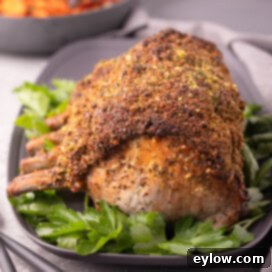
Pistachio-Herb Crusted Pork Rib Roast
Sally Cameron
Pin Recipe
Equipment
-
Small roasting pan with a sturdy rack that fits inside
-
Food Processor recommended for easy crust preparation, or chop by hand
-
Digital Meat Thermometer (wired or wireless is highly recommended for accuracy)
Ingredients
For the Pork Rib Roast
- 4 pound 5-rib bone-in pork roast chine bone removed, ribs frenched (optional)
- 2 teaspoons creamy Dijon mustard
- 2 teaspoons whole grain Dijon mustard
- kosher sea salt to taste
- freshly ground black pepper to taste
- granulated garlic optional, for extra flavor on the meat
For the Pistachio-Herb Crust (makes extra)
- ½ cup raw, shelled, unsalted pistachios
- ¼ cup chopped fresh Italian parsley
- 2 tablespoons seasoned breadcrumbs (use gluten-free or regular)
- 1 tablespoon fresh chopped thyme
- 2 large fresh garlic cloves finely chopped or minced
- avocado oil spray
Instructions
Preparation & Pre-heat
-
To ensure the most even cooking and a tender result, remove the pork rib roast from the refrigerator at least 1 hour before you plan to roast it, allowing it to gradually come closer to room temperature. After about 30 minutes of tempering, pre-heat your oven to a precise 325°F (160°C). Prepare your roasting pan by thoroughly coating the wire rack and the bottom of the pan with avocado oil spray to prevent any sticking during the roasting process.
Craft the Pistachio-Herb Crust
-
In the bowl of a food processor, combine all the designated crust ingredients: the raw, shelled pistachios, fresh chopped Italian parsley, seasoned breadcrumbs (either gluten-free or regular), fresh chopped thyme, and the finely chopped fresh garlic cloves. Pulse and process these ingredients until the mixture is finely chopped but importantly, still retains a slight texture – avoid over-processing it into a paste. You’re aiming for a coarse crumb. If you do not have access to a food processor, you can achieve a similar result by mincing all ingredients very finely by hand and then thoroughly mixing them in a bowl.
Season & Crust the Pork
-
Pat the pork rib roast completely dry on all surfaces with paper towels. This critical step helps create a crispier exterior and ensures optimal adhesion for the mustard and crust. Season generously on both sides and ends with kosher salt and freshly ground black pepper. If desired, apply a light, even dusting of granulated garlic directly to the meat for an enhanced savory flavor. In a small bowl, thoroughly mix the creamy Dijon and whole grain Dijon mustards, then brush this blended mustard mixture evenly over the entire top side of the roast. This mustard layer will act as a flavorful binder. Finally, cover the top side of the roast thoroughly with the prepared pistachio-herb mix, patting it firmly and evenly to ensure it adheres well. Insert your meat thermometer probe into the side center of the thickest chop, being careful to avoid touching any bone.
Roast to Perfection & Rest
-
Carefully place the prepared roasting pan with the crusted pork into your pre-heated 325°F (160°C) oven, using the conventional setting. Roast until your meat thermometer registers an internal temperature of 140°F (60°C). It is important to note that the temperature will continue to rise to the ideal 145°F (63°C) as the roast rests after its removal from the oven, ensuring a perfectly cooked and juicy result.
Important Note: It is crucial to keep a close watch on the color development of the crust, especially during the final phase of roasting. If you observe that it begins to brown too quickly or appears to be getting overly dark, loosely tent the top of the roast with aluminum foil to protect it from further direct heat, preventing burning while allowing the meat to finish cooking.
For a standard 4-pound roast, typical cooking time is approximately 2 hours and 20 minutes, but please remember that oven performance and roast dimensions can vary. Always prioritize roasting to the target internal temperature, not solely by time, for the most consistent and best results.
-
Once the roast reaches 140°F (60°C) and is removed from the oven, it is essential to allow it to rest undisturbed on a cutting board for 15-20 minutes before attempting to slice it. This crucial resting period is vital for the juices to redistribute evenly throughout the meat, guaranteeing a moist and exceptionally tender roast. After resting, use a sharp carving knife to slice precisely between the ribs, creating individual, thick, and impressive pork chops. Arrange them elegantly on a platter and serve immediately, perhaps with any collected pan juices.
Notes
If you do not possess a specialized wire rack that fits inside your roasting pan, a clever and effective alternative is to lay a few sturdy stalks of celery or thick slices of onion across the bottom of the pan. This will effectively elevate the roast slightly, crucially allowing for better air circulation underneath and promoting an even, crispy crust. Simply discard the celery or onion after the roasting process is complete.
For those seeking a versatile, durable, and particularly easy-to-clean alternative to a traditional wire roasting rack, consider investing in this highly recommended silicone roasting rack. It performs wonderfully for achieving even heat distribution and makes post-meal cleanup an absolute breeze.
